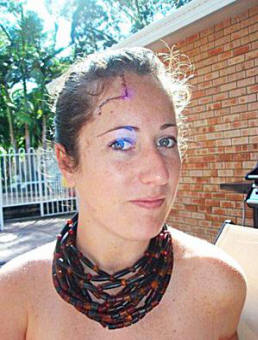Skin cancer is common in the middle-aged but young people are at risk as well, writes Sarah McInerney.

Bree Wailes after the skin cancer was cut out of her forehead.
It wasn't until Bree Wailes was in the hospital waiting room that it hit home that she had skin cancer.
She was diagnosed earlier this year, aged 25, with basal cell carcinoma on her face. This was after noticing a patch of flaky skin that felt itchy and tingly.
After a biopsy confirmed it was cancer she had it surgically removed in a procedure that required 26 stitches and left her with a lightning bolt shaped scar.
"It really didn't click until I was in the waiting room and I was the youngest person there by 20 or 30 years," she said.
"They were looking at me as if to say 'what are you doing here?'."
Despite having a family history of skin cancer, Wailes was shocked to be diagnosed at such a young age as she had been "pretty careful" about applying sunscreen and wearing a hat.
She hopes by speaking out about her experience other young people will realise skin cancer is something that could affect them.
"It is something young people don't care about," she said.
"They think being tanned looks healthy. I don't think looking like a leather handbag looks good at all."
National Skin Cancer Awareness Week runs until November 22 and the Cancer Council is using the opportunity to highlight the behaviour of young people in the sun.
According to its most recent sun protection survey, undertaken over summer in 2006/2007, one in four teenagers aged 12 to 17, are still getting burnt on a summer weekend, compared to 14 per cent of adults.
Almost one third of those said they forgot to protect themselves and 26 per cent said they had stayed in the sun for too long.
While fewer teens were actively seeking a tan than when the survey was first run in 2003/2004, 82 per cent said they were in the sun for about two hours during peak UV times.
Only 4 per cent wore a wide-brimmed hat compared to 24 per cent of the adults surveyed.
Cancer Council Australia chief executive Professor Ian Olver said adults were getting the message but younger people needed to be targeted more effectively.
"More than 430,000 Australians get skin cancer and 1600 Australians die from it each year, yet most skin cancer is preventable simply by being SunSmart," he said.
The SunSmart principles are slip, slop and slap plus seek shade and slide on some sunglasses.